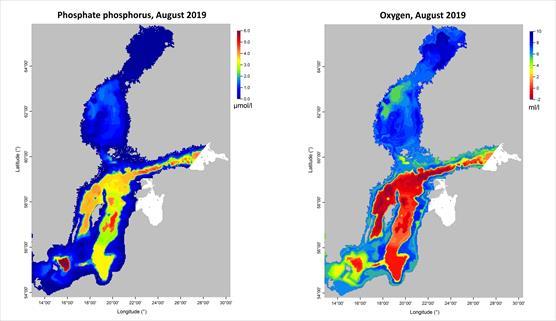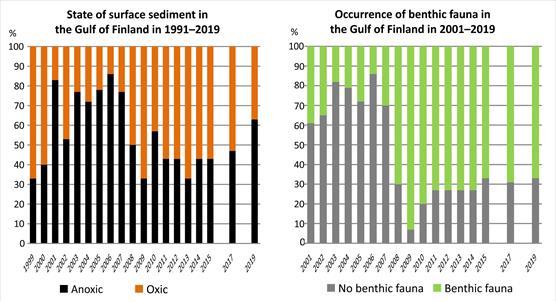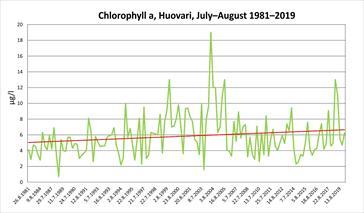Press release 2019-09-06 at 9:56
In the Gulf of Finland, the areas suffering from oxygen depletion have expanded from last summer. The anoxic areas and areas with very low oxygen in the Baltic Proper are approximately similar in size than in the autumn of 2018, when the Swedish Meteorological and Hydrological Institute estimated them to be more extensive than ever before. The oxygen situation in the Bothnian Sea and the Bay of Bothnia is good, like last year, as indicated by the Finnish Environment Institute’s monitoring results from summer 2019.
The marine research vessel Aranda and Kala 6, the vessel used in 2019 for coastal monitoring, have returned from their August expeditions. During these excursions, SYKE studied the eutrophication of the sea, the oxygen situation near the seabed and changes in the planktonic and benthic communities. The SYKE research area covers the north-eastern part of the Baltic Sea Proper, the Gulf of Finland, the Archipelago Sea and the Gulf of Bothnia. In addition, SYKE has had in its disposal the Swedish Meteorological and Hydrological Institute’s (SMHI) new monitoring data from the Baltic Proper and the southern Baltic Sea.
The expeditions are normally carried out once a year, and they are part of the SYKE Marine Research Centre’s programme for the monitoring of long-term changes in the Baltic Sea. The research also contributes to the joint HELCOM monitoring conducted by the Baltic Sea countries.
Phosphate released from the bottom of deep basins in the Baltic Proper
The oxygen conditions in the Baltic Proper are poor, and the levels of dissolved phosphorus are high near the seabed. The anoxic areas and areas with very low oxygen levels are approximately as extensive as in 2018. These areas cover the whole deep area of the Baltic Proper including deeps to the west of Gotland. Water in the Baltic Proper is now anoxic below 70–75 metres. Furthermore, the phosphorus levels in the deep basins of the Baltic Proper are higher than in the previous years. Under anoxic conditions, phosphate phosphorus is released from the bottom sediment and accumulated into deep waters.
The salinity in the Bothnian Sea and the Bay of Bothnia is, overall, at the same level as in previous years and the oxygen situation remains good. However, the oxygen content in the north-western deep basin of the Bothnian Sea is slightly lower than in previous years. No significant changes were detected in the dissolved nutrient levels in the Bothnian Sea and the Bay of Bothnia. Due to sills in the seabed in the Sea of Åland, the changes occurring in the Baltic Proper have not affected the state of the Bothnian Sea.
Also in the Archipelago Sea the salinity and oxygen content remain, for the most part, at last year’s level. Only in the southern parts of Skiftet the oxygen content has slightly decreased, which may be a result of the poor situation in the Baltic Proper.

The oxygen conditions in the Baltic Proper are poor. The anoxic areas cover all the deep parts of the basins of the Baltic Proper, and reach far into the Gulf of Finland. The phosphorus levels in the basins of the Baltic Proper and in the Gulf of Finland are higher than last year. © Data: SYKE and SMHI
Saline stratification and nutrient situation still exceptional in the Gulf of Finland
Since the autumn of 2016, old, saline, oxygen-depleted and phosphorus-rich deep water has been flowing into the Gulf of Finland as a result of the major Baltic inflows. In the deep areas of the Gulf of Finland, the seabed suffers from oxygen depletion all the way to the easternmost parts of the Gulf. The situation is worse than it was this time last year. Water in the whole of the Gulf of Finland is highly stratified.
The expansion of the anoxic areas is also visible at the permanent monitoring stations along the northern coast of the Gulf of Finland. The share of stations having anoxic surface sediments was 30 per cent higher than two years ago. However, benthic fauna was still found at two thirds of the stations. The main reason for the number of stations with benthic fauna remaining the same is that, since 2008, an invasive species that tolerates extremely low oxygen levels, the red-gilled mud worm (Marenzellaria spp.), has become increasingly common in the seabed in the deeps of the Gulf of Finland.

The state of bottom sediment and benthic communities at the 30 permanent monitoring stations in the Gulf of Finland. © SYKE
In the eastern Gulf of Finland, the halocline and thermocline are located at depths of 20–30 metres. Beneath them there are considerable volumes of saline water with elevated phosphate levels. The levels have increased further when compared to the same time last year. The amount of phosphorus ending up in the surface layer is of crucial importance from the perspective of next summer’s cyanobacterial blooms. It all depends on wind conditions during the rest of the autumn and ice conditions over the coming winter.
In terms of cyanobacterial blooms, this past summer was not as bad as the summer of 2018 in the Gulf of Finland. Based on the chlorophyll levels indicating the amount of algae, the eutrophication level of the sea area is currently at approximately the same level as it was three decades ago. Summertime cyanobacterial blooms peaked in the Gulf of Finland in the early 2000s; throughout the following decade the amount of algae decline, until this trend was halted in 2016. Now the algal levels are on the rise even in the eastern Gulf of Finland, where nutrient load has been reduced in the 21st century more significantly than anywhere else in the Baltic Sea area.

Measurements performed at the Huovari intensive monitoring station in Virolahti indicate that algae levels are once again on the rise, also in the eastern Gulf of Finland. © Data: ELY Centre for Southwest Finland and SYKE
The phenomena behind the exceptional saline stratification and nutrient situation in the Gulf of Finland are related to currents determined by climatic factors and conditions in the Baltic Proper. Changes in the state of the Baltic Proper have a crucial impact on the nutrient, oxygen and algae situation in the Gulf of Finland. This means that emissions must still be cut in the entire drainage basin of the Baltic Sea.
The surface temperature of the Baltic Sea has increased by almost two degrees since 1990, and it is estimated to continue increasing significantly due to climate change. This will increase the risk of cyanobacterial blooms in the future. Higher water temperatures and stronger stratification may expand the anoxic areas in the seabed, which in turn will accelerate the release of phosphorus from the bottom sediment. In addition, the increasing probability of winter rainfall will also cause more and more nutrients to drain into the sea from the catchment area.
Further Information:
- Gulf of Finland: Research Professor, Aranda Cruise Leader Maiju Lehtiniemi, Finnish Environment Institute SYKE, tel. +358 (0)295 251 356, firstname.lastname@ymparisto.fi
- Gulf of Finland coastal monitoring: Senior Research Scientist Seppo Knuuttila, Finnish Environment Institute SYKE. tel. +358 (0)295 251 286, firstname.lastname@ymparisto.fi
- Gulf of Bothnia and Archipelago Sea: Senior Researcher, Aranda Cruise Leader Pekka Kotilainen, Finnish Environment Institute SYKE tel. +358 (0)295 251 317, firstname.lastname@ymparisto.fi
- Communications Specialist Eija Järvinen, Finnish Environment Institute SYKE, tel. +358 (0)295 251 242, firstname.lastname@ymparisto.fi
Pictures for media use: